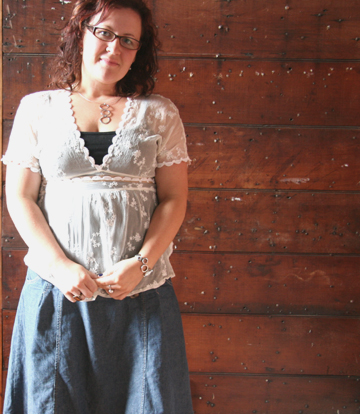
by tashmcgill | Dec 4, 2007 | god ideas, Uncategorized
Self Portrait

She’s been loud, she’s been quiet and meek. She’s been sitting in a field of wheat and the light was golden, she finally grew older. Finally got to stand up on her own two feet. This girl, finally finding voice with which to speak.
Song Of The Moment : Something About What Happens When We Talk
Lucinda Williams
If I had my way I’d be in your town
I might not stay but at least I would’ve been around
Cause there’s something about what happens when we talk
Something about what happens when we talk
Does this make sense It doesn’t matter anyway
Is it coincidence or was it meant to be
Cause there’s something about what happens when we talk
Something about what happens when we talk
Conversation with you was like a drug
It wasn’t your face so much as it was your words
Cause there’s something about what happens when we talk
Something about what happens when we talk
Well I can’t stay round cause I’m going back south
But all I regret now is I never kissed your mouth
Cause there’s something about what happens when we talk
Something about what happens when we talk
Cause there’s something about what happens when we talk
Something about what happens when we talk
by tashmcgill | Dec 3, 2007 | Uncategorized
Brick By Brick
The days are starting to pile up with commitments and things to do – which is part of the joy and the stress of the season. Saturday was spent at the one day ‘vision & direction’ leadership day for church.
We were presented with a Circle of Discipleship, a youth ministry application of the church-wide acronym S-E-R-V-E (Spiritual Formation, Evangelism, Relationships, Volunteerism, Excellence), a Pyramid of Focus, the 4321 Term Ratio in regards to the youth ministry. All this within a 5 year plan. It was then broken down into sections of focus and our feedback was offered in a variation of “identify strengths/identify weaknesses/identify possible solutions or additions”.
It’s a structure that’s built on some solid principles, but the overwhelming questions that each discussion group I was in eventually centred around was the character, flavour, surprise and flexibility of community & people. So perhaps it was just that I carried my own loud voice into each discussion, but perhaps it is also true that within this structure and picture of tomorrow – there is also a desperate need for breathing spaces. For people who are not followers of Jesus to find places of belonging and peace within our community.
More than anything, I want to remind our new leaders – that 5 year plans are not the key to success. Perhaps sticking at it for 5 years is the way to ‘succeed’ – but a community that didn’t flex, grow, shake and outgrow it’s structure over the space of five years – isn’t really embracing the fullness of their humanity, nor the divinity at work amongst them.
So – here’s to patience and remembering again, that whether you succeed or fail, it’s worth busting out of the starting blocks with good people alongside you. People who make you laugh and bring mirth into your life.
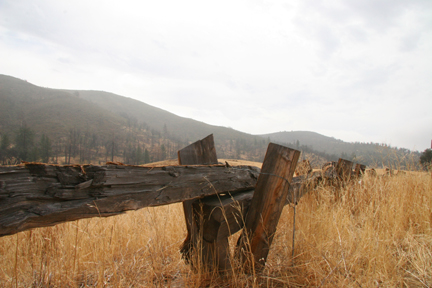
by tashmcgill | Nov 29, 2007 | god ideas, Uncategorized
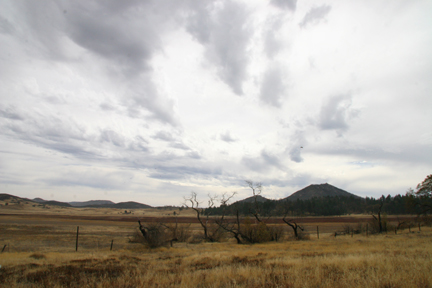

Connectivity In The Spaces
If I close my eyes and slow my breathing down, I can hear the wind blowing through the desert, on my way past Julian. It’s a small mountain town famous for apple pie, best served warm with cinnamon icecream made the old fashioned way. The temperatures changes by vast degrees regardless if you’re measuring in fahrenheit or centigrade. The fall of the hill down to the east takes you into flat, wide open spaces where the sun beats down the day. You can pull up on the side of the hill and listen for a minute full before the rushing wind falls quiet enough to let you hear the desert breathe.
Eventually with all things good, the road runs out of turns that thrill and you cast your eyes back over the hill through Julian once more. You can stop for gas at a tiny store, buy beef jerky and bottled water for the road with crumpled dollars and counted out dimes. Climbing through 2000ft past the lakes with signs forbidding stopping before you know you’re back into the skylines filled with power lines. There are fences to the left and to the right, burnt out scars with blackened bark. The silhouette of trees that stood through fires that died before I knew this road.
I like the West Coast when facing east, it seems so warm and full of intrigue. Discovery is my good friend, the radio on silent once we hit the bends of roads that climb and curve away and through new places learned. This is all I think of when I close my eyes. I think next year, when I fly away I’m coming back to roam again through mountaintops and desert plains, to feel the heat and keep the wind.
Community Worked.
Had a very inspiring lunch with one of the girls from my old group today. Even though it’s only been a short 11 months without them every Wednesday, I sure do miss them. They have become part of the young adults ministry with new leaders being integrated – it’s hard but good – they are loathe to lose the flavour that we worked so hard to build over the last two years we spent together. It’s wonderful to see that the experiment has worked. They are thriving, they are deep, they are loving with all sorts of people. I am delighted to be their friend.
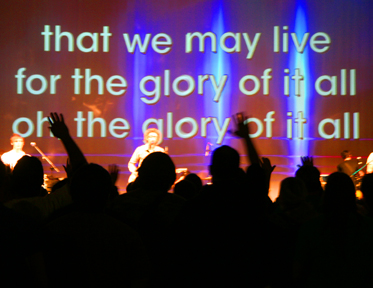
by tashmcgill | Nov 22, 2007 | god ideas, Uncategorized, worship
Worship In The Key Of Home

I can tell already that I’m going feel unfinished and dissatisfied with this post – but here goes. One of the biggest personal observations that I made in the US, was this nagging sensation that some component of ‘gathered singing worship’ was missing.
I’m reducing it down to this – worship is not only key to community, but a context of community is key to worship. The role of local narrative is vitally important to some (not exclusive) aspects of worship as the people of God.
It started in Chicago with a sense of disconnection from ‘local’ songs like Mighty to Save & Hosanna being sung by 2500 strangers. The song was familiar, but the story was not. If I partake in the metanarrative/grand narrative by virtue of my belonging in the kingdom, I still remain connected to my local narrative. At first I put the sense of disconnection down to being away from home and still singing songs that I was so connected to.
However, in Indianapolis, I sang songs that were even older, with which I had personal, individual narrative to connect with and I stood with family in a foreign church worship environment. This too had it’s conflicts and strange rumblings.
In St Louis, I started to dig back into my “Worship in Context” studies and ruminating over the role of gathered worship in the life of the Israelites both in local and grand narrative. I realised the significance of connecting the songs of praise/lament/sorrow/supplication to our narrative in local scale. To gather as the ‘people of God’ but as relative strangers serves a joyous purpose of extravagant praise, but left something amiss in my heart. It felt somehow incomplete.
As I made friends and started to share my individual story with people around me, we collectively built some ‘local’ narrative. The physicality that the worship leaders called for – the dancing, clapping, shoulder & hand connections began to feel more comfortable. After all, NYWC isn’t just a corporate gathering – there is already a commonality to the local narrative of youthworkers around the globe.
So what does this mean? Well, maybe nothing new except to say that if I worship as one, then my ‘worship’ can take any form, indulging in the individual narrative, bathing in romance and wonder. But when I worship in community, I am now going to abandon my ‘one-ness’.. when I worship with people now, gathered worship is going to become exactly that.. I’m going to look for ‘our’ stories as well as drawing attention to ‘the’ Story. What will that mean? I gosh-golly don’t know.
If nothing else, my “with-worship” has to live up to the challenge of telling local narrative with it’s struggle, celebration, sorrow and fullness. Like any good story, “with-worship” must have a sense of connecting people and ideas, with darkness and light in contrast.
What about “all-worship”? The impending festival season approaches with annual pilgrimages planned, culminating in the Parachute festival at the end of January. Do the numbers determine the role of ‘my-narrative”, “our-narrative” and “the-narrative”? I don’t think so – but I’m still trying to answer the questions around how that could or ought to look.
I think that smaller faith communities have much more of an advantage here – the intimacy of the “our-narrative” seems much more accessible on a smaller scale, but the bigger question is how do I implement a connection between ‘worship liturgy with a lot of singing’ and the active, fluid, responsive “our-narrative” of the church community.
I’m also wondering about what it means for the “our-narrative” of denominational gatherings, training gatherings, volunteer gatherings. After all, why do so many Christian gatherings that have nothing to do with gathered singing worship, always start with gathered singing worship? More on that later…
by tashmcgill | Nov 7, 2007 | god ideas, Uncategorized
The Rise and Rise Of The Youth Ministry Profession
In the seminar “the expectations that killed the youthworker”, I got to thinking about the meteoric rise of youth ministry as a profession. And anything that becomes a profession, is usually accompanied by the various training establishments that develop career pathways, books, conferences and assorted assistance materials.
There is much similarity between youth ministry and starting a business. Success is really the domain of intangible measurements, because in the beginning it’s hard to find language that makes us feel comfortable with numbers. It’s no surprise that business publications like “Good to Great” sit just as easily with entrepreneurial youthworkers, similar to John Maxwell’s “The 21 Irrefutable Laws of Leadership” sitting well with business leaders.
There is a difference though between the rise of youth ministry professional development and more generic business/secular models. That is, where professional development resources and requirements have grown and expanded, the equal and necessary requirements of professional practice have not necessarily been fulfilled.
The way I see it, professional practices is more than just good employment contracts and well thought out interview & review structures that build healthy employer/employee communication strategies. It’s also creating work environments that support the flow of new ideas, the review and implementation of those new ideas which further support the ongoing mission of the organisation.
Examples of this might look like a corporate reading list and discussion opportunities; a list that includes ideas that both challenge and support the current models of thinking. The context and content of staff meetings being shaped beyond communication of information and entering into the dialogue of ideas. In addition, accepted practices for raising and resolving potential conflict situations, accepted & explicitly communicated, even group developed processes for employee movement, incoming, outgoing, sideways. Most of our churches seem like they could really use some intentional human resources training.
Pastors & church leaders might be really good with people, but not necessarily working for others, employing others or working alongside others. We teach leadership as vision, communication and conflict resolution, but relegate human resources to ‘management’ of paperwork, payroll and holidays.
I guess all this to say, that I’ve been thinking our professional development of individuals has surpassed the development of our practices and process. I think inevitably you then hit a roadblock when the ongoing discussion and development of ideas requires an environment of good practice that doesn’t exist.
In addition to this, I’m thinking that true professional development includes not just gaining qualifications and/or experience but also includes a commitment to developing the thinking muscles. The aspects of the mind that are committed to assessing, engaging with and applying ideas and knowledge that may come from the other side of the fence.
Partly this is just because I love to explore and examine both sides of the argument, but also it’s because part of the transition from milk to meat is learning to think for yourself but with others. The ideas and convictions of those that are different from us should push and stretch us beyond ourselves, not be dismissed as irrelevant without examination.
Part of refining our professional development is learning first to think constructively in an environment of challenging ideas.. delaying our disagreement in order to engage with the issue at hand. In other words, learning the evidential process of reasoning. Disagreement comes after you’ve done the work of assessment and examination. Model that back into staff environments where there is ongoing differing information and ideas being communicated between multiple ministry or staffing areas, different ideas being adhered to, different priorities being reasoned with.. learning to engage with the issues first is really healthy for a staff team that wants to grow, whether you’re leading that team, on that team or volunteering for that leadership team.
Big lesson in my own life, because I process sometimes too fast, and arrive at the conclusion (right or wrong) at such speed that it can be intimidating and ‘unfair’ on others I’m dialoguing and engaging with. So.. slowing down the Conclusion Speed and doing justice to the Data Analysis. Healthy, slow and strong.
NZ Application:
When we only have one national training event (in two locations) each year, how do we take advantage of that premise to introduce new and challenging ideas into the information pool of our youthworkers (fulltime/parttime/training/volunteers)? How do we activate some of our own “best practices” in the professional development area?
If we currently base our training models on the Certificate modules, incorporated into the degree structure of a broader applied theology degree – supplemented by a ‘college of peers’ such as the Youth Pastors Summit, and BYM National Leaders Training .. how can we expand our individuated and collective thinking processes?
For example, this year we engaged Duffy Robbins as keynote speaker. His focus was really 80% functionality / 20% personal development. It was good, solid and really suitable for anyone in their 1 – 3rd years of youthwork at any level. Familiarity with his work outside that context would have provided further insight into the expansion of the ideas. However – mostly those are ideas that are developed or communicated in some way through the training programmes available through YouthTrain and/or Carey.
Should we instead deliberate engaging speakers/seminar/workshop hosts that are more challenging or complex? Should we focus those gatherings that are an opportunity for dialoguing and interaction with our collective “information pool” to be issues-based? Push people to grapple with the broader issues around youth ministry? For example, Steve Gerali’s presentation material around adolescent sexuality would definitely hit the buttons. Perhaps there is something for engaging with the relatively silent and yet steady Catholic youthwork community in NZ.
The deeper question beyond all this, is how can I help youthworkers back home engage and expand both their individual professional development (substitute the word ‘thinking’), the local environment and professional practices they engage with (local church/employer/leaders) and the wider environment they participate in (the collective information pool)?
Some (not exhaustive) levels of training/understanding/engagement.
1. Practical understanding of the purpose of youth ministry.
2. Practical skills/functionality (leading a small group/writing a programme).
3. Foundational philosophies shaping individual youth ministries (your own).
4. Ideas/Challenges shaping broader youth ministries models & philosophies.
What kind of training best happens where? Where do we leave the word training behind and start to use the words dialogue, engagement, thinking, development?
What are the requirements of understanding and engagement at each level?
Who is responsible for execution or opportunity for development at each level?
You’re Not Even A Youthworker Anymore, Why Do You Care?
Firstly, shut your mouth, my-alter-ego-accusing-self. I am a youthworker and it’s an identity I’m so happy to own and admit failing at.
Secondly, I really do care a lot because if you look at the old adage “if you always do what you’ve always done, you’ll always get what you’ve always got” there has to be a way of getting off the hamster wheel.
The acquistion and
understanding of new ideas and information is key to any kind of short or longterm change. Foundational philosophical shifts, fads and trends all follow the same rule. Introduce new information into the cycle “hamster wheel”, and the cycle has to accomodate and shift to allow for new information to take effect, thereby changing the pathway. What I really want, is to find ways of introducing new information and ideas both individually and collectively, that disrupt the hamster wheel altogether.

by tashmcgill | Nov 7, 2007 | Uncategorized
Letters From America 2.2 – Stories From Indiana
Well, I’m here .. in San Diego at long last with dear dear friends Marko and Jeannie. Well technically, Marko’s not here, still enroute from Grand Rapids. Technically it’s also my birthday .. well just, for another few hours. I’m sad to not be with family and friends back home in NZ or even in Brownsburg but… it’s also quite fun to have a birthday that lasts for 32 hours instead of the regular 24hours. And these friends are lovely too!
The Dance of Falling Leaves and Other Adventures In Indiana

Walking through the Maple Ridge Trail in a cool autumn afternoon, you see the final cycle of summer coming to it’s close. The leaves hang by tender thread to branches drying out in the wind. The crisp blue light of clear mid-western skies falls down through golden tree cover and the breeze comes through the branches with enough gasp that the last of the leaves slip out of their grasp and descend to the ground. But the descending is just transcendant because the wind coming through the woods is slow and easy enough that the leaves just twirl and waltz their way to the forest floor. It’s like watching cartoon snowflakes but in red and gold maple leaf stars instead. Standing in the midst of a shower of falling red and gold, falling gently and slowly enough to be captured on film and to watch with wonder is like standing under warm water rain for the first time. The rising breeze hits your nose with still clean grass and the sweetness of decay setting in.
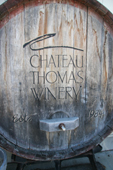
We drove out through Plainfield and stopped at the Chateau Thomas winery for a sunday afternoon tasting. Indiana is one of those states you still can’t purchase alcohol on a Sunday, unless at a restaurant. The winery counts as a tourist attraction so is governed by different policy but it still felt good to be breaking the rules. A wide assortment of zinfandels, blush wines and shiraz blends was on offer from the barmaid who was probably more aptly suited to the phrase Wine Nazi. Within moments of thinking it, she echoed my own thoughts by gleeing telling us her exact nickname was precisely that. Suitably impressed that I asked for water to cleanse the palate between each tasting she brought out the gold star award winning wines for my tasting pleasure. Unfortunately my winetasting buddies made the mistake of sampling from the chocolate selection before supping the complementing wine. Tut tut. They received the short, sharp and icy cold shoulder from the buxom, blonde, big-haired mid-western lass. Turns out though, that she walks in the same park behind the Brownsburg abode as I, home to the Maple Ridge Trail and all.
There are plenty of people to meet when it comes to travelling through new places. And then there are those that you don’t meet, but you observe or just plain hear about, like the old man on the bicycle that liked to ride around the park. He’d ring the bell on his 1960s pushbike to let you know he was coming. Trouble was, he was ringing it a full three minutes before he got to where I was by which time I’d forgotten again. He lapped me four times and it was the same each one. Ding, ding, ding and then he crawled by at snails pace.
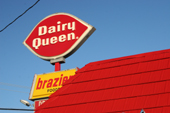
There’s Keith, who works in my uncle’s shop and got married the Monday after I arrived. Took two days off, the first day for the wedding where he roasted a whole pig for the party, got married to a bride wearing camoflage pants and an orange tshirt in the backyard of their house. They served up as much roasted hog as they could and still had to load the rest into the freezer next to the other critters they’ve collect for good eating. Same hatchet that was used to carve and cut the pig was used to cut the cake, a red velvet interior with white buttercream icing. You can imagine the glory of the new bride and groom, dressed as they were with hatchet in hand. It comes as no surprise to learn that both are returned from various forms of military service. Keith took Tuesday off work as well but by Wednesday had had enough honeymooning so was back at the workshop, along with 15 bags of roasted pork and buns for lunch. It was a good day to stop by.
Weird Neighbour deserves the capitalisation of his nickname, as well as a cautionary approach at all times. Renowned for being a little unusual, the first words of warning I received from any and all regarding my stay in Indiana were typically “Watch out for weird neighbour.” You could be forgiven for thinking that it was just because of the upcoming Halloween festivals that a fully grown man would dress in full costume (sometimes a park ranger, sometimes Santa Claus, sometimes a Hungarian shepherd boy) and sit outside his house. But no, according to the locals, that’s year round madness to enjoy right there. Occassionally his mother joins in as well, which made for a heightened awareness on October 31st. It’s not unusual for the Brownsburg police to be stopping by the brick and tile on the corner. However, Weird Neighbour remained relatively quiet and sedate for the duration of my stay, even on the 31st, when the scariest little trick-or-treater came knocking on the door so hard I thought the glass was due to break. Then he yelped “trick or treat, wanna smell my feet” while digging a chubby claw into a bowl of fun-size chocolate bars. With eight or so of them in his sticky, hot grasp he turned and hightailed it for the sidewalk where his parents were waiting patiently. What a little punk. The unexpected bonus of all that Halloween activity are the amazingly discounted kids dressup costumes (handy dandy for the men in my life, jesse and liam) and the practically fast food service at the restaurants we ate at, an early birthday dinner!
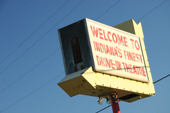
I took the truck out and hightailed it respectably through some of the small towns that lie along highway 36 and 136. The cornfields and farmhouses that were so beautiful in 2004 have almost all made way for new subdivisions with enchanting names like Stoney Creek and Oaks Crossing. Even the Clermont drive-in is finally facing the final curtain call. Clermont was not only the finest drive-in experience in Indiana, but it was also one of the first multiplexes ever. Now it’s just a dustbowl of steel pipes, swings and slides with two white monuments to cinema facing off against one another at the first stand. The romance of it all is falling under the construction spell of the expanding population.
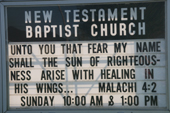
Traversing 36 and 136 I found a cornfield opposite a church, the sign offering more hope than perhaps what I was expecting. The light was getting more and more opaque into the evenings, but I was glad for that one cornfield in the midst of the sadness of years of family history and hardwork being covered in by concrete. In a nation of consumers, that’s it’s still more financially rewarding for farmers to let go of family property into the hands of developers and superstores. Even some into church parking lots for the expansive houses of worship. The road into the heart of downtown Indianapolis doesn’t reflect any of that expansive skyline though. Short and broad brick bungalows line the street pushed up next to railroad lines, over bridges and
industrial buildings being built and falling down on top of each other. Washington Street takes you from the Wal*Mart superstore in Avon right through the executive homes in the outer belt of Indianapolis proper, then through the Latin populated suburb, complete with walk-up stores and festivities. Then down beside the Indiana Zoo, Victory Field and the White River State Park, you find yourself in the one-way grid of Monument Circle.

You can tell a friendly city not by the doors of the inner-city churches flung wide open into the daylight, or by the lack or presence of street folks. It’s the free parking offered in the central city that is the biggest clue. It says… stop here a while. Pick up a hot chocolate and bonbon from the chocolatier, listen to the local radio being broadcast outside it’s studio. Walk around the monument to mid-west boys that fought in the Great Wars, Korea and Vietnam. The architecture rises tall around the Circle, but the streets are wide enough to allow for streaming light to hit the cobblestones. It’s a clean, bright city.

The drive back to Brownsburg from the city is a mixed observation of small houses slowly being rebuilt, repainted, refreshed and those that almost seem like they’re collapsing in on themselves, the weight of all this city progress just a little too much. The people are friendly though, no matter where you stop, unless it’s at Bob Evans, where the waitresses are stealing from you left and right. Thankfully, the somewhat corrupted manager and her boyfriend were since disposed, but not before becoming the talk of the town. Uncle John knew he’d seen her face somewhere before..hehe. Yup, small town is still small town, even when small town is getting bigger by the day.
So, that’s Indiana.















